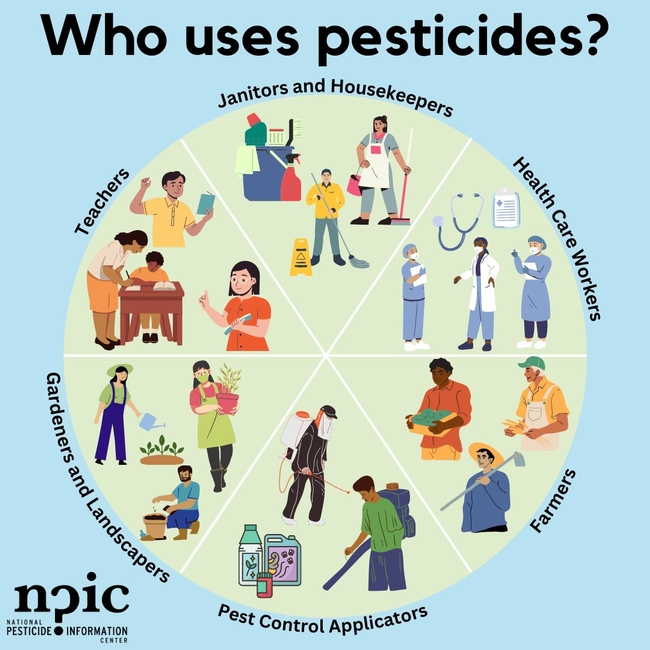If you've used disinfecting wipes to clean surfaces in your home, an herbicide to control weeds in your garden, or insect repellents while on a hike, then you have used a pesticide. A pesticide is any material (natural, organic, synthetic, or even homemade remedies) that is used to control, prevent, kill, or repel a pest. Pesticides are designed to be toxic against certain pests like weeds, insects, or bacteria. But when they are not used properly, pesticides can also be toxic to people and pets, and harm the environment including water quality, pollinators, and natural enemies.
February is National Pesticide Safety Education Month, a time to raise awareness about pesticide safety. Keeping yourself, your family, and the environment safe from pesticides starts with reading and understanding the pesticide label. Below are some key things to look for and follow on the label.
- Where can you use it? Some pesticides can be used on both edible and ornamental plants, indoors and outside. But other pesticides may explicitly state that they should not be used indoors, on edible plants, etc. Always be sure the label states that it can be used where you intend to use it.
 Teachers, janitors and housekeepers, healthcare workers, farmers, pest control applicators, gardeners and landscapers, and many more use and can be exposed to pesticides. Photo from the National Pesticide Information Center (NPIC).
Teachers, janitors and housekeepers, healthcare workers, farmers, pest control applicators, gardeners and landscapers, and many more use and can be exposed to pesticides. Photo from the National Pesticide Information Center (NPIC). - Signal words. The signal words Danger, Warning, or Caution on a pesticide label indicate the immediate (acute) toxicity of a single exposure of the pesticide to humans. Pesticides with the signal word Danger are the most toxic. Look for products with the signal word Caution, as these pose less risk of toxicity.
- What should you wear to protect yourself? When handling most pesticides, you should usually wear a long-sleeve shirt, pants, closed-toe shoes, eye protection, and chemical resistant gloves (not gardening gloves). This prevents you from being exposed to the pesticide through your skin, eyes, lungs, or mouth. For some other pesticides, like insect repellents you apply to your skin, read and follow the label for specific instructions.
- How long after applying can you enter the treated area? For many home-use pesticides, you can enter the treated area when the pesticide has dried. Entering an area where the pesticide is still wet can expose you to those chemicals. Some pesticide products may state that you must wait a certain number of hours before reentering the area.
- When can you harvest treated produce? If you applied a pesticide to your edible plants it's important to know when it is safe to harvest and consume them. Many pesticides can be applied to edible crops up until the day of harvest, but some pesticides may require days or weeks to pass before it is safe to do so.
- How should you store the pesticide? Pesticides should always be stored in their original container with the lid tightly sealed, in a locked storage cabinet where children cannot access them. Improper pesticide storage can lead to exposure incidents, such as a child drinking a pesticide or spilling it on yourself.
Following the pesticide label can prevent unintentional pesticide exposure to people and pets. To prevent harm to the environment, you should also follow these general guidelines:
- Don't apply pesticides in rainy or windy weather. If it is actively raining and windy, or rain is expected, hold off on applying the pesticide. Applying during rainy or windy weather can cause the pesticide to be washed away, polluting stormwater and waterways. It can also cause drift, which is when pesticide droplets or dust move through the air. Drift can harm nearby plants, bodies of water, or people.
 Even naturally derived and organic materials can be pesticides. Like all pesticides, they should be used with caution to avoid harm to yourself, others, and the environment. Photo by Belinda Messenger-Sikes, UC IPM.
Even naturally derived and organic materials can be pesticides. Like all pesticides, they should be used with caution to avoid harm to yourself, others, and the environment. Photo by Belinda Messenger-Sikes, UC IPM. - Don't spray plants in bloom. Protect pollinators and natural enemies (good bugs) that feed on pollen and nectar by not spraying flowering plants.
- Dispose of pesticides at your local household hazardous waste (HHW) site. Pesticide containers that are partially or entirely filled should be taken to a HHW site to prevent environmental contamination. Empty, rinsed pesticide containers can be disposed of in the garbage or recycled if accepted in your area.
Happy National Pesticide Safety Education Month. Visit Pest Notes: Pesticides: Safe and Effective Use in the Home and Landscape to learn more about pesticide use and safety.

